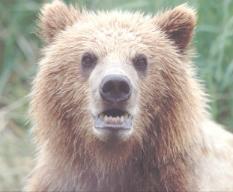Consider now the Grizzly Bear, there’s information I could share
About this noble, fearsome beast, of which we used to know the least
Of any mammal of its, size, carnivorous or otherwise.
Let’s classify the Grizzly Bear, because you know we really care,
Its Latin name is sure to thrill us, Ursus arctos horribilis,
It isn’t every day you see the Grizzly Bear’s taxonomy.
The western US, most of that, was its historic habitat,
Look at a map and you can see the Grizzly Bear’s geography,
Today the range in which it mates is limited to just four States.
That doesn’t count Alaska though, or Canada, just States below,
Montana has the most, you know, but Washington and Idaho,
Also Wyoming have a few, besides the San Diego Zoo.
One hundred thousand used to roam and call the western US home,
Now only one percent or less live in the lower west US,
And they’re no longer everywhere that used to host the Grizzly Bear.
The problem all across the nation is encroached civilization,
Now people play and houses go on spaces the Grizzly used to know,
The bear must now get by with less, in forests, parks and wilderness.
You ask, “What does the Grizzly eat?’ Just anything, let me repeat,
The Grizzly’s never known to fuss ‘bout food ‘cause he’s omnivorous,
There’s grass and berries, grubs a treat, and carrion, all kinds of meat.
Another Grizzly food is fish; it’s just about his favorite dish,
There’s ants and pine nuts, roots and bark, a ground squirrel and a meadowlark,
And if it has a putrid smell, the Bear enjoys it very well.
That’s why when garbage is around, or dug up from beneath the ground,
The Grizzly gets an easy meal, which constitutes a crummy deal,
For we should not, a Bear so great, with human food, habituate.
Sometimes a band of wooly sheep will tempt a Grizzly Bear to leap
Upon a lamb, perhaps a ewe, and thus enjoy a feast or two,
Sheep ranchers then may have to change to country out of Grizzly range.
When walking in the woods, take care, you may not see the Grizzly Bear,
So, whistle, sing or ring a bell; make lots of noise so they can tell
There’s people that they might avoid, but crowd their space, they’ll be annoyed.
They may attack if you’re too near, or bluff a charge to make you fear,
So stand your ground or maybe fall and roll yourself into a ball,
But one thing that you must beware: “You can’t outrun a Grizzly Bear!”
And when you camp where Grizzlies live, take extra care that you don’t give
Them easy access to your food; you’ll find the Bear extremely rude
And most aggressive to procure whatever that you don’t secure.
So hang your food away up high, but never pitch your tent nearby,
Don’t go to bed in clothes you wear to cook, because the Grizzly Bear
May sniff you out, because his nose detects the smell of food on clothes.
Grizzlies eat all summer season huge amounts and here’s the reason:
They must build up thick fat store, because for five long months or more,
Though it is hard to contemplate, they neither eat nor defecate.
As winter comes, the Bear will crave to dig a small and cozy cave,
Grizzlies practice hibernation; sows complete their odd gestation,
So cubs or born inside the dens, and bare and blind, their lives begin.
This tiny runt without much hair, you’d scarce believe a Grizzly Bear,
But they find mama’s warmth and milk, until their coats are smooth as silk,
They venture out one fine spring day, with mama showing them the way.
In fact, she teaches them it all, from early spring until late fall,
And then they dig another den, and sleep all winter long again,
The season when the cubs are two, their time with mama is all through.
And she hunts up a handsome boar, or he finds her, I’m not quite sure,
In any case, they mate in spring, and then takes place the strangest thing,
Just like suspended animation, it’s called, “delayed implantation.”
Which means, although the sow’s gestation takes two months, a strange gyration,
The tiny embryos don’t grow, until her den is under snow,
So, while in spring the two Bears mate, the pregnancy is five months late.
Grizzly Bears are solitary, all alone and always wary
Of people, even other bears, and so he rarely ever shares
His food and/or his favorite places, doesn’t care to see new faces.
It was in nineteen seventy-three, that Congress, though not all agree,
Produced a most important pact, call the Endangered Species Act,
And Grizzlies, to complete the story, are in a “threatened” category.
And so, recovery is the goal, and many actors play a role,
Their fate is up to you and me, with guidance from the IGBC,
Let’s show the world we really care, and let’s conserve the Grizzly Bear!
Provided with kind permission from
Stan Tixier, cowboy poet and second chairman of the Interagency Grizzly Bear Committee ,IGBC, (1985-1987).



